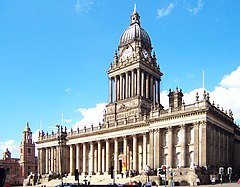Leeds Town Hall
| Leeds Town Hall | |
|---|---|

Leeds Town Hall in 2006
|
|
| General information | |
| Architectural style | Classical/Baroque |
| Town or city | Leeds |
| Country | England |
| Construction started | 1853 |
| Completed | 1858 |
| Client | Corporation of Leeds |
| Design and construction | |
| Architect | Cuthbert Brodrick |
Leeds Town Hall was built between 1853 and 1858 on Park Lane (now The Headrow), Leeds, West Yorkshire, England, to a design by architect Cuthbert Brodrick.
Until early 1813, the Moot Hall at the top of Briggate was the seat of Leeds Corporation and was used for judicial purposes. It was replaced by a new court house on Park Row, Leeds.
Leeds went through a period of rapid growth in the first half of the 19th century and by the mid-19th century it became apparent that the court house was no longer large enough for the functions it performed. In July 1850, Leeds Borough Council decided to build a new town hall and established a committee to assess the opinions of Leeds' inhabitants as to the building of a new municipal hall.
In order to finance the town hall, the council proposed to sell shares in the building to the value of £10 but the proposal failed. The council then proposed introducing a specific rate levied to fund its construction although it was not introduced until after the November 1850 local election, and most residents who would have paid the tax at the time lacked voting rights. The town hall was approved in January 1851 when Alderman Hepper put the motion to the council and it was carried by 24 votes to 12. It was intended to represent Leeds' emergence as an important industrial centre during the Industrial Revolution and symbolize civic pride and confidence.
Leeds Corporation tendered for designs from architects and the contract was won by Cuthbert Brodrick, an unknown architect from Kingston upon Hull who had trained in Paris. The building contract went to Samuel Atack, who completed most of its construction before the hazards of a large building project ultimately led to his bankruptcy.
Leeds Town Hall was subject to much criticism during its construction. The original estimated costs were vastly exceeded and the corporation had to find extra funding at a time when there was great poverty among the Leeds' working classes. Samuel Atack's main problems as the builder were: changes in design and difficulties with the architect; the Crimean War, because army recruitment caused a shortage of workmen and a rise in wages; and deadline pressures arising from Queen Victoria's agreement to open the building.
...
Wikipedia
